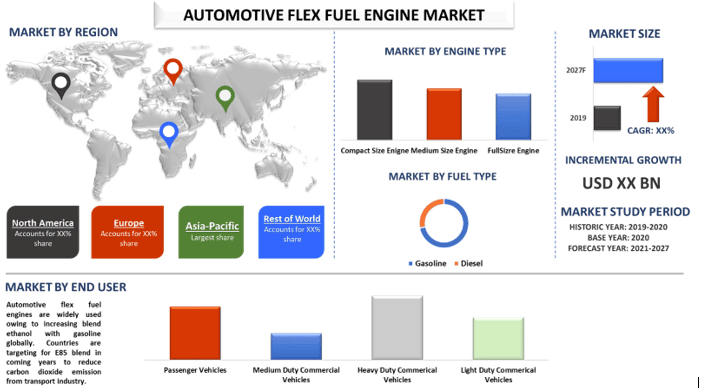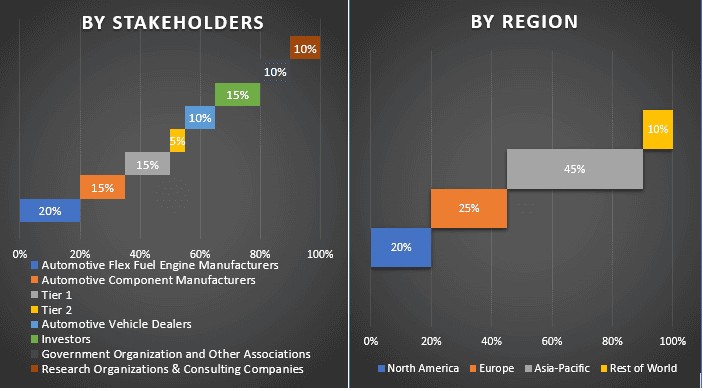- Home
- About Us
- Industry
- Services
- Reading
- Contact Us
Automotive Flex Fuel Engine Market: Current Analysis and Forecast (2021-2027)
Emphasis on Engine Type (Compact Size Engine, Medium Size Engine, Full Size Engine); Fuel Type (Gasoline, Diesel); End User (Passenger Vehicles, Medium Duty Commercial Vehicles, Heavy Duty Commercial Vehicles, Light Duty Commercial Vehicles); Region/Country

Global automotive flex fuel engine market is likely to demonstrate reasonable CAGR of 6% during the forecast period (2021-2027). Globally, governments are shifting towards low carbon economy. Since, transportation releases 29% of world’s total CO2, therefore vehicles manufacturers are focusing on research and developments of automotive flex fuel engines which is highly suitable for long run as countries are frequently changing their norms for ethanol blending. Automotive flex fuel engines are flexible with any blend of ethanol. In addition, in developing economies governments are increasingly adopting E20 blend which requires flex engine, this would further fuel the demand of automotive flex fuel engines.
Insights Presented in the Report
“Amongst Engine Type, compact and medium size engine together held prominent market share in 2020.”
Based on engine type, compact size engine, medium size engine, full size engine are the 3 categories of engines on which flex fuel engines are divided. Compact engine designs are evolving to include more technology aimed at increasing performance as well as offering a lower weight solution to vehicles. They are cost efficient and consume less fuel due to their usage in light vehicles. Medium size engines are majorly used in combustion ignition engines for heavy duty purpose which generates high power majorly used commercial vehicles.
“Amongst Fuel Type, Gasoline held lucrative market share in 2020.”
On the basis of fuel type, automotive flex fuel market is divided into gasoline, diesel, and others. Currently, gasoline holds lucrative market share as sales of gasoline run vehicles is more than the cars run by diesel. For example, in India 67% of petrol cars were sold in 2020 while 29% being diesel. Europe is aiming to achieve a milestone of E85 blend which would require cars equipped with flex fuel engines this would further boost the demand of automotive flex fuel engine. In 2020, 47.5% petrol and 28% diesel engine cars were sold in European Union. Higher sales of gasoline-based vehicles would result in more manufacturing of gasoline-based flex fuel engine leading to the growth in market size of automotive flex fuel engine.
“Amongst End User, passenger vehicles held lucrative market share in 2020.”
Based on end user, the market is categorized into passenger vehicles, medium duty commercial vehicle, heavy duty commercial vehicle, and light duty commercial vehicles. Over the decades, demand of passenger vehicles has been significantly rising with increasing disposable income and higher standard of living. Moreover, in today’s scenario having a car has become status symbol which has somehow influenced the demand of passenger vehicles. Rising demand of passenger vehicles would help the flex fuel engine grow faster as compared to commercial vehicles. Although, a sales decline of ~15% was observed in passenger vehicle in year 2020 which was mainly owing to Covid-19 crisis.
“Asia Pacific represents the considerable markets in the Global Automotive Flex Fuel Engine Market.”
For a better understanding of the market adoption, report provide detailed analysis for major region and countries including North America (US, Canada, Rest of North America), Europe (Germany, UK, Russia, France, Spain, Rest of Europe), Asia-Pacific (China, Japan, India, Australia, Rest of APAC), and Rest of World. Asia Pacific held the considerable market share in 2020 and is expected to retain its position during the forecast period owing to presence of world’s most populated countries like India, China, Bangladesh which are highly dependent on crude oil imports are heavily investing in new technologies like flex fuel engines which reduces carbon dioxide released from vehicles. In addition to countries are increasingly pushing the adoption of alternative fuel vehicles, which helps in controlling oil consumption which eventually would result in low oil imports
Reasons to buy this report:
- The study includes market sizing and forecasting analysis validated by authenticated key industry experts
- The report presents a quick review of overall industry performance at one glance
- The report covers in-depth analysis of prominent industry peers with a primary focus on key business financials, product portfolio, expansion strategies, and recent developments
- Detailed examination of drivers, restraints, key trends, and opportunities prevailing in the industry
- The study comprehensively covers the market across different segments
- Deep dive country level analysis of the industry
Table of Content
Analyzing the historical market, estimation of the current market, and forecasting the future market of the automotive flex fuel engine were the three major steps undertaken to create and analyze its adoption across the globe. Exhaustive secondary research was conducted to collect the historical market numbers and estimate the current market size. Secondly, to validate these insights, numerous findings and assumptions were taken into consideration. Moreover, exhaustive primary interviews were also conducted, with industry experts across the value chain of the automotive flex fuel engine industry. Post assumption and validation of market numbers through primary interviews, we employed a bottom-up approach to forecast the complete market size. Thereafter, market breakdown and data triangulation methods were adopted to estimate and analyze the market size of segments and sub-segments the industry pertains to. Detailed methodology is explained below:
Analysis of Historical Market Size
Step 1: In-Depth Study of Secondary Sources:
Detail secondary study was conducted to obtain the historical market size of the automotive flex fuel engine market through company internal sources such as annual report & financial statements, performance presentations, press releases, etc., and external sources including journals, news & articles, government publications, competitor publications, sector reports, third-party database, and other credible publications.
Step 2: Market Segmentation:
After obtaining the historical market size of the automotive flex fuel engine market, we conducted a detailed secondary analysis to gather current market insights and share for different segments & sub-segments for major regions. Major segments included in the report are engine type, fuel type, end user. Further regional and country-level analyses were conducted to evaluate the overall adoption of the automotive flex fuel engine globally.
Step 3: Factor Analysis:
After acquiring the historical market size of different segments and sub-segments, we conducted a detailed factor analysis to estimate the current market size of automotive flex fuel engine. Further, we conducted factor analysis using dependent and independent variables such as rising CO2 emission which is leading to air borne diseases and government’s supporting policies etc. A thorough analysis was conducted for demand and supply-side scenario considering top partnerships, merger and acquisition, business expansion, and product launches in the automotive flex fuel engine industry.
Current Market Size Estimate & Forecast
Current Market Sizing: Based on actionable insights from the above 3 steps, we arrived at the current market size, key players in the global automotive flex fuel engine market, and market shares of each segment. All the required percentage shares split, and market breakdowns were determined using the above-mentioned secondary approach and were verified through primary interviews.
Estimation & Forecasting: For market estimation and forecast, weights were assigned to different factors including drivers & trends, restraints, and opportunities available for the stakeholders. After analyzing these factors, relevant forecasting techniques i.e., bottom-up approach was applied to arrive at the market forecast to 2027 for different segments and sub-segments across the major regions globally. The research methodology adopted to estimate the market size encompasses:
- The industry’s market size, in terms of value (US$) and the adoption rate of automotive flex fuel engine across the major markets
- All percentage shares, splits, and breakdowns of market segments and sub-segments
- Key players in the automotive flex fuel engine in terms of services offered. Also, the growth strategies adopted by these players to compete in the fast-growing market.
Market Size and Share Validation
Primary Research: In-depth interviews were conducted with the Key Opinion Leaders (KOLs) including Top Level Executives (CXO/VPs, Sales Head, Marketing Head, Operational Head, and Regional Head, Country Head, etc.) across major regions. Primary research findings were then summarized, and statistical analysis was performed to prove the stated hypothesis. Inputs from primary research were consolidated with secondary findings, hence turning information into actionable insights.
Split of Primary Participants in Different Regions
 Market Engineering
Market Engineering
Data triangulation technique was employed to complete the overall market estimation and to arrive at precise statistical numbers of each segment and sub-segment of the global automotive flex fuel engine market. Data was split into several segments & sub-segments post studying various parameters and trends in the automobile industry.
The Main Objective of the Automotive Flex Fuel Engine Market Study
The current & future market trends of global automotive flex fuel engine were pinpointed in the study. Investors can gain strategic insights to base their discretion for investments from the qualitative and quantitative analysis performed in the study. Current and future market trends would determine the overall attractiveness of the market at a country level, providing a platform for the industrial participant to exploit the untapped market to benefit as a first-mover advantage. Other quantitative goals of the studies include:
- Analyze the current and forecast market size of automotive flex fuel engine in terms of value (US$). Also, analyze the current and forecast market size of different segments and sub-segments
- Segments in the study include areas of engine type, fuel type, end user.
- Defined analysis of the regulatory framework for the automotive flex fuel engine industry
- Analyze the value chain involved with the presence of various intermediaries, along with analyzing customer and competitor behaviors of the industry
- Analyze the current and forecast market size of the automotive flex fuel engine for the major countries
- Major regions/countries analyzed in the report includes North America (US, Canada, Rest of North America), Europe (Germany, UK, France, Spain, Rest of Europe), Asia-Pacific (China, Japan, India, Australia, Rest of Asia-Pacific), and Rest of World.
- Company profiles of the automotive flex fuel engine players and the growth strategies adopted by them to sustain in the fast-growing market
Deep dive country level analysis of the industry
Related Reports
Customers who bought this item also bought










